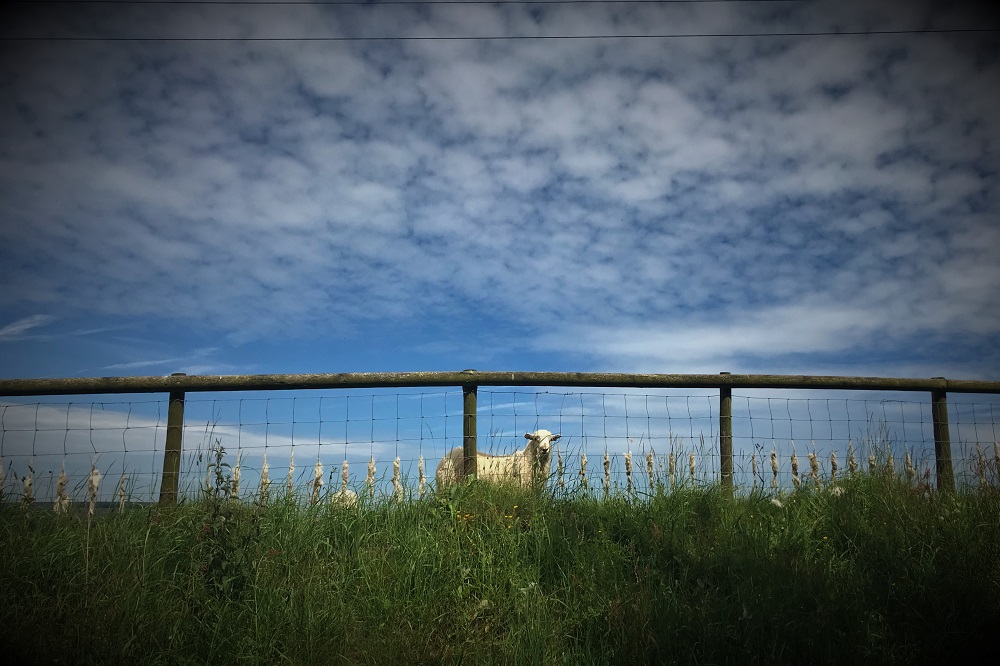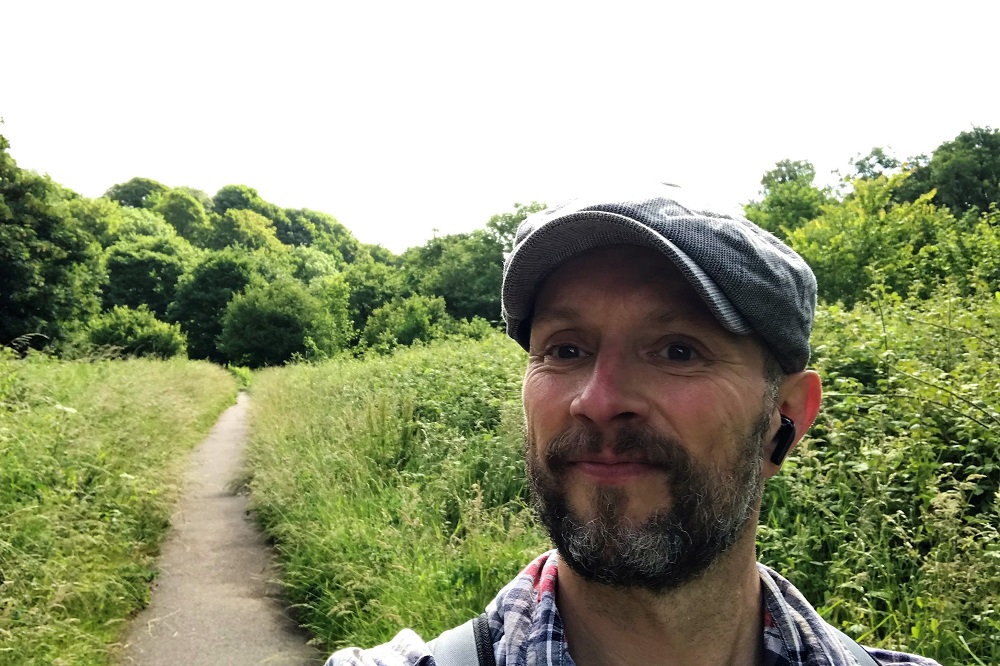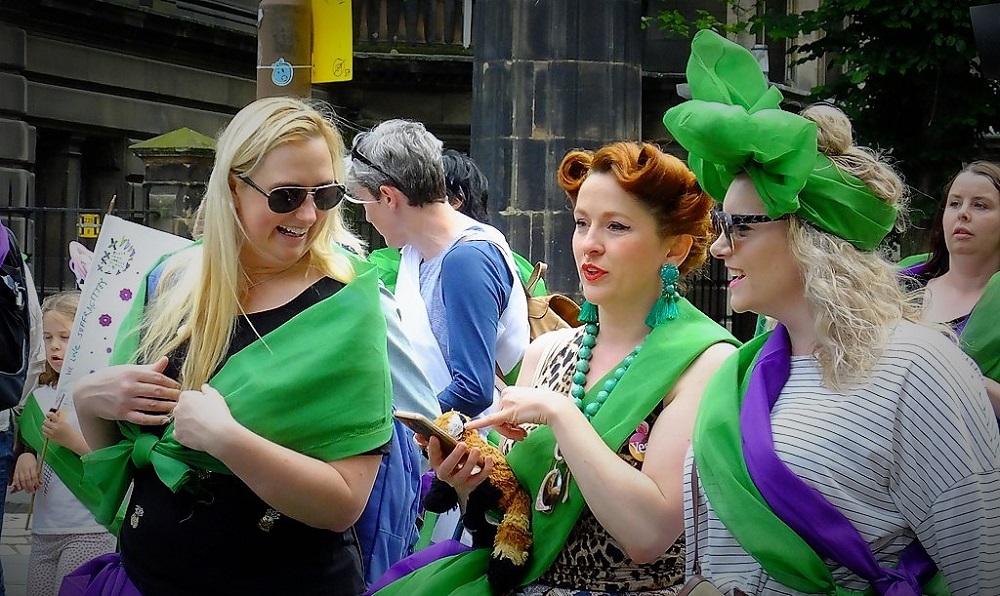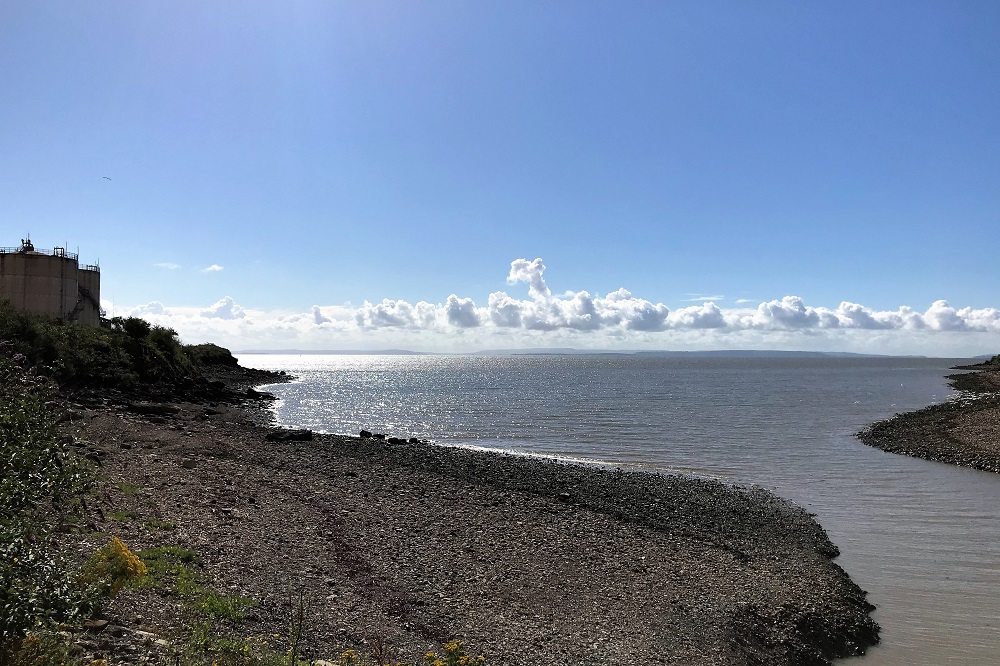This walking life – stepping out with David Llewellyn

David Llewellyn
In mid-June I saw a promotion for the British Red Cross’s ‘Miles for Refugees’ campaign, raising money for refugees from Ukraine and elsewhere.
It mentioned the UK Govt.’s stalling and inaction on this, and suggested that aspiring fundraisers might walk 108 miles, the distance from Lviv to the safe crossing points of the Polish border.
I’d already walked around 70 miles, and so I set up a GoFundMe. This was the kind of fundraiser I could quite literally take in my stride. I’m a lifelong walker from a family of walkers.
I was an early and enthusiastic talker long before I mastered getting about on two feet. While still in nappies I said “Czechoslovakia” in response to my mum asking what I was watching on TV.
Walking was quickly followed by cycling, when I was given a bike for Christmas, made in the factory where my father was a foreman.
This in turn led to tobogganing, when he and his workmates made their kids sleds welded together from metal offcuts, with wooden slats for a seat, and a rope for steering, infinitely more sophisticated than the plastic sleds on which friends went skittering hazardously down the snowy hillsides.
Dad went on to become a self-employed car mechanic, running his own garage in Garndiffaith, but neither my brother nor I ever learned to drive, and were never encouraged to.
Neither was he keen for us to follow in his footsteps, as it was a job with which he became increasingly disillusioned.
Now in his 70s, he drives rarely, makes full use of his bus pass, and believes the future lies in greater investment in public transport.
Trudging
Our maternal grandfather, a mineworker and briefly a mechanic and Lance Corporal in the REME, never drove.
His courtship of my grandmother involved three-mile hikes from Blaenafon to her family home in the village of Llanelly Hill.
One of those visits resulted in the birth of my Auntie Margaret, born three months after Gordon and Elizabeth Gait were wed, something I learned of only when we went through Margaret’s possessions after she died, aged 80, in 2017, and found their marriage certificate, dated October 1936.
My father grew up further down the valley, spending his childhood at Twyn Gwyn, a farm near the ruins of Pontypool’s folly tower, built by the Hanburys in the 18th Century and demolished in the 20th to prevent the Luftwaffe using it to locate the Royal Ordnance factory at Glascoed.
When my aunt and uncle – also farmers – married during one of the harshest winters on record, she was taken to the church through Pontypool’s American Gardens on a tractor, while my father and others followed after them, trudging through the snow in their wellies.
Even when we went on daytrips Dad would insist on parking as far from our destination as he could, leaving us to walk what felt like miles and miles to the museum, zoo, castle or seaside funfair we were visiting.
Whenever we went to his old childhood haunts we’d hike it, up the hill, past the farm to the scattered stones of the old tower, and down into Pontypool Park.
Other trips might take us to the Keeper’s Pond in Blaenafon, and beyond it to the memorial for Foxhunter, the champion show jumping horse of our namesake Harry Llewellyn.

Walking uphill
Aged 8 or 9 and forbidden from going to Pontypool Park alone, I snuck out of the house and walked there anyway, prompting panic stations till I nonchalantly pressed the doorbell on my return.
Aged 12 a gang of us would walk or cycle along footpaths invariably nicknamed “the line”, after the railways which once passed through the valley, occasionally discovering bin bags filled with dirty magazines, mysteriously left behind by persons unknown.
To get to Cwmffrwdoer Primary School, we had to climb Zion Hill, while my secondary – and Roy Jenkins’ alma mater – Abersychan was halfway up the near vertical Old Lane.
The Pontypool campus of what is now called Coleg Gwent sits atop a hill with sweeping views of Pontypool and Cwmbran.
It’s hardly surprising that those of us who grew up in the valleys of South Wales have an advantage when it’s “legs day” at the gym. We were practically born walking uphill.
Therapeutic
Dartington College of Arts, where I was a student from 1997-2000, wasn’t on any bus routes, and was almost three miles from the nearest high street.
Through spring and autumn mud-spattered jeans were a daily occurrence. In my second year I lived with four others, two couples, on a farm in Ashprington, some 5 miles from Dartington, in the rolling hills of South Hams.
When the weather was favourable, I’d often walk to and from college, shedding much of my first year’s beer and junk food weight.
If it was raining, I might hitchhike, meeting some of the more colourful locals, including an elderly woman with bright orange hair, a tree surgeon with a randy dog and an elderly couple from one of Totnes’s churches driving a visiting young Amish couple from Pennsylvania into the town.
Those long walks followed my first heartbreak and an utterly miserable autumn and winter – the depression I’d yet to name was at its worst – but they proved therapeutic.
From the winding country lanes, I watched trees coming into leaf, and had my progress slowed by herds of sheep in the weeks before lambing season.
On clear nights the sky, untainted by streetlights, would be full of stars, and I saw the glint of light from the International Space Station, shortly after its first solar panels had been installed.
On other nights you might see the waving beams of distant lighthouses or hear and feel the ominous whump of munitions being tested on Dartmoor.
Exploring
In my final year, during an extended summer break, I attended a rave on a farm near Castleton, between Cardiff and Newport, the wake for a Big Issue vendor nicknamed Full-On John.
With all the decorum of ravers and clubbers we marked his passing by dropping acid and dancing till daylight, but by 8am I was done. I asked a friend where I could catch a bus, and he laughed.
The nearest bus stop was in Newport, and the first buses wouldn’t run until 11am. He begged me to stay, to keep the buzz going, but mine had worn off hours ago.
I was sick and tired of listening to men in tie-dye droning on about “the thinginess” of it all, and so in glorious sunshine, my Adidas Sambas quickly drenched with dew, I set off for Newport.
Like many others during the first Lockdown walking became a pastime and my only form of regular exercise.
Waking early, I would go out, exploring the deserted streets and parks, taking photographs of vacant shops and cafes, the latter with chairs stacked or upside down on the tables.
Later, venturing out into the less urban bits of Cardiff, my partner Dan and I discovered previously unknown nature reserves and beauty spots.

Wanderer
In recent years it’s become a tradition to spend his birthday, in early January, in West Wales, always in places remote, and preferably without Wi-Fi.
The first, in 2016, on the weekend that Bowie died, was a beautiful cottage on a farm in North Pembrokeshire, and we hiked to and from the town of Newport in an exhausting 12-mile round trip.
Four years later, with talk of a virus several weeks away, we were back in Pembrokeshire, this time in a cosy eco-cabin closer to Newport.
Once again, we walked there and back, buying well-deserved pints at Bluestone Brewery’s tiny makeshift bar on our return.
It was a misty morning, and when we were halfway home, I posed for a photo at a gateway overlooking Newport, my back turned to the camera, like Caspar David Friedrich’s ‘Wanderer’.
Most recently we hired an impossibly picturesque log cabin near Castell Moel in Llangain, walking the 6 miles to Llansteffan, dreaming of a pub grub lunch for the entire journey.
We arrived to find the village deserted, a ghost town of empty holiday homes and not a single pub was open. Even the beachside fish and chip bar was closed.
It was the unassuming village shop, which sold magazines, sweets and bottles of pop, which came to our rescue.
Passing through it we entered a small backroom bar with tables and chairs and a sizeable menu of gluten free pizza, with the vague air of a speakeasy.
Pilgrims
There’s a long tradition of walking for the sake of it, or for some purpose, spiritual or political.
Chaucer’s pilgrims may have been inspired by his own youthful journey along the Camino de Santiago in northern Spain, and Petrarch is often hailed as the first mountain climber, for his personal account of a hike up the slopes of Mount Ventoux.
Poets of the Romantic Age did little else but wander, with Wordsworth’s excursions around the Wye Valley above Tintern, and John Clare walking 80 miles from a lunatic asylum in Epping Forest to Northamptonshire, as recreated by the actor Toby Jones in Andrew Kotting’s 2015 film By Our Selves.
Many years later film director Werner Herzog walked from Munich to Paris in a bid to save his mentor Lotte Eisner, as described in his 1978 book Of Walking in Ice.
40 years later Polish-British photographer Michal Iwanowski walked from his home in London back to his hometown in Poland, spurred on by a graffito reading GO HOME POLISH, as detailed in Cardiff director Ian Smith’s documentary film of the same name.

Women’s rights
Many more have walked for their rights.
The United Procession of Women saw 3,000 suffragettes march from Hyde Park Corner to the Strand.
In 1936 two hundred men from Jarrow marched almost 300 miles to London, with a petition protesting against unemployment in the northeast of England.
As the Civil Rights movement gathered pace in the early 1960s 250,000 African Americans marched on Jim Crow-era Washington D.C., demanding freedom and jobs.
Britain’s first true Pride march took place in 1972, when a festival parade of Queer men and women walked from Hyde Park to Trafalgar Square.
I’ve taken part in pretty much the same march several time since then, once striding a few feet from Peter Tatchell; I in a Stars and Stripes cowboy hat, brandishing cap guns, while he held aloft a banner.
Beginning in 2011 the SlutWalk movement, which sees women taking to the streets in clothes deemed “slutty”, is an international protest campaign against rape culture and victim blaming, inspired by the Toronto police officer who said women should avoid “dressing like sluts”.
Six years later the election of Donald Trump led to the Women’s March, whose organisers accurately predicted the deleterious effect his brief presidency would have on women’s rights.

Radical
There’s something radical about walking, especially at a time when we’ve begun to question our dependence on oil.
I’ve had some funny looks from drivers while walking where there is little or no pavement. How dare I stroll past them, sometimes overtaking them, as they sit there in their half mile tailbacks?
To walk is to step away from all that, to slow things down and make the journey as meaningful as the getting there.
Against a backdrop of Russia’s ongoing war against Ukraine and the schadenfreude-enriched downfall of Boris Johnson, these walks raising money for the British Red Cross often felt like an urgent and necessary act of resistance.
My last long walk took me along the coastal path, past the Rover Way gypsy and traveller site, only days after the UK Govt. moved to criminalise their way of life.
Realising I was lost two men from the site gave me directions that got me home. On my way back, overlooking the River Rhymney, I saw their horses grazing on the marshland.
By the end of the day I had raised £230 and walked 152 miles, those last two a stroll to Amgueddfa Caerdydd, where I stood perfectly still before Cedric Morris’s painting of Loughor and Penclawdd.
Support our Nation today
For the price of a cup of coffee a month you can help us create an independent, not-for-profit, national news service for the people of Wales, by the people of Wales.




